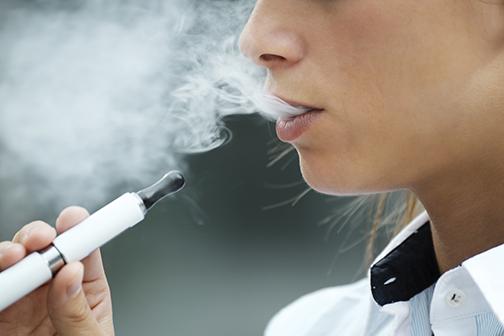Most of us grew up during a time when cigarette smoking was being systematically shunned. Throughout the course of a few decades, cigarettes were banned from airplanes, workplaces, and eventually restaurants and bars. Finally, smokers were forced to the outer edges of society … or at least to the outside of buildings if they wanted to light up.
The argument was that this measure was meant to save nonsmokers from unwanted exposure to secondhand smoke in public places and clearly label smoking as socially unacceptable.
This, along with ever-increasing taxes on cigarettes, succeeded in helping Americans kick the habit. According to the American Lung Association, the prevalence of smoking has decreased by more than 50 percent since 1965. The regulations have continued to spread and cigarette ads were banned from television. For a while, it was starting to look like bad news for Big Tobacco.
Then came e-cigarettes, and America jumped on board in a big way. They were marketed as being safe and odor-free, a healthy alternative to smoking cigarettes: no nasty side effects, no stigma and you could use them anywhere. After all, it’s not real smoke, right?
“It’s just vapor.”
This became the unofficial tagline of sorts, quick out of the mouths of every e-cig smoker.
Apparently, people implicitly trust vapor. They bought into the vapor explanation without hesitation, or without any critical thinking, for that matter. I sincerely doubt many e-cig smokers could tell you what is actually being vaporized, but that’s beside the point. The point is, you could smoke inside again, and it doesn’t even smell bad. That must mean it’s safe, right?
If e-cig smokers took the time to look into the details about their lovely little toys, they would find two concerning things. Namely, e-cig manufacturers aren’t required to offer ingredient lists for the chemical cocktail that fills their product. And for the fun twist, guess who e-cig manufacturers actually are? That’s right—Big Tobacco.
Altria Group, Inc., makers of Camels and Parliaments, is a huge player in the multi-billion-dollar e-cig industry. Lorillard, maker of Newport cigarettes, also manufactures blu eCigs, the most popular brand on the market.
[quote]Now that you know the same people who have sold “cancer sticks” for decades are the ones making your e-cigs, how certain dare you of their safety? [/quote]How much trust do you have in the vapor now?
Truth is, the nicotine in e-cig cartridges are actually at potentially toxic levels of concentration. The Center for Disease Control reported receiving more than 500 calls regarding nicotine poisoning from e-cigs this past February alone, and they weren’t just about babies eating refill cartridges. More than 40 percent of calls were concerning adults 21 and older.
Even if vapor is safer than smoke by nature, it’s still nicotine. The addictive aspect is still there, and addiction is inherently unhealthy. The nicotine part has been clear all along, so why consumers ever considered them safe is hard to understand.
There was a time in history when cigarette manufacturers were not yet regulated by the FDA either, and could advertise their product as safe, even though science had proven otherwise. That gave them plenty of time to build up a market of addicted customers.
[quote]E-cigs have been doing just the same, building a reputation on unsubstantiated claims and good ad campaigns while they still can.[/quote] The difference is, we really should have known better the second time around.
Fortunately, just like their paper-wrapped predecessors, e-cigs are finally falling under regulatory fire. Los Angeles County recently instituted a ban on e-cigs in parks, restaurants and workplaces. Even our very own San Diego State has prohibited the faux smoke on campus. CNN reported the FDA has proposed bringing e-cigs under its regulatory reach in order to institute strict regulations.
We can expect e-cigs will fade out of fashion, much as tobacco use as a whole has declined since its mid-century peak. But fear not, Big Tobacco will more than likely be back soon enough with another clever gadget to trick the public into continued addiction. Hopefully, the next time around, consumers will remember to be smarter than the advertisement.
Photo courtesy of Thinkstock







